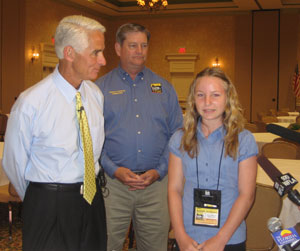 A middle school student from Merritt Island was in the spotlight at the 2007 Florida Farm to Fuel Summit last week in St. Petersburg for her work in making biofuels.
A middle school student from Merritt Island was in the spotlight at the 2007 Florida Farm to Fuel Summit last week in St. Petersburg for her work in making biofuels.
Yep, you read that right. Erin McCaskey, 12, attends Thomas Jefferson Middle School and her seventh grade science project last year was making biodiesel from a variety of sources.
“I got five different types of oil – used peanut oil, peanut oil, vegetable oil, corn oil and Wendy’s oil (leftover from a local restaurant),” said Erin. “And I made biodiesel and I tested that and E-85 and B-20 in a calorimeter for their energy content.” Used peanut oil was declared the energy winner by Erin.
For her eighth grade project, Erin will be making ethanol from different sources. She sees a bright future for biofuels. “There’s so many ways you can make biodiesel and ethanol – it’s amazing.”
Erin received recognition for her work from Florida Governor Charlie Crist and Agriculture Commissioner Charles Bronson.
Here’s an interview I did with Erin at the Summit: [audio:http://www.zimmcomm.biz/audio/f2f-erin-edit.mp3]
And here’s a great post about Erin on the BIOStock Blog by C. Scott Miller.
Follow up: I found out that young Erin got more than just recognition from the governor at the Summit – she also received a free ride to the college of her choice, courtesy of Florida state representative Marty Bowen, Haines City. Read more from the Miami Herald.


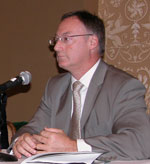 The main focus of the Florida Farm to Fuel Summit in St. Petersburg last week was getting biofuels production going in the Sunshine State.
The main focus of the Florida Farm to Fuel Summit in St. Petersburg last week was getting biofuels production going in the Sunshine State. “We have the only existing fuel ethanol plant in Florida,” said Banks. “With an aim of being up and running by the summer of 2008. For that, we need about four million bushels of something.”
“We have the only existing fuel ethanol plant in Florida,” said Banks. “With an aim of being up and running by the summer of 2008. For that, we need about four million bushels of something.” “In the longer term, in my judgment, the fuel of the future is going to be hydrogen,” Dorgan said. “I’m a big fan of the biofuels, I’m a big fan of ethanol, I believe it’s enormously important that we’ve invested in wind energy. But I believe —especially in the longer term — our grandkids need to be driving vehicles that put water vapor out the tailpipe and have twice the efficiency of power to the wheel. That comes with hydrogen fuel cells. It allows us to say to the Saudis and the Kuwaitis and others, ‘We don’t need your oil.’”
“In the longer term, in my judgment, the fuel of the future is going to be hydrogen,” Dorgan said. “I’m a big fan of the biofuels, I’m a big fan of ethanol, I believe it’s enormously important that we’ve invested in wind energy. But I believe —especially in the longer term — our grandkids need to be driving vehicles that put water vapor out the tailpipe and have twice the efficiency of power to the wheel. That comes with hydrogen fuel cells. It allows us to say to the Saudis and the Kuwaitis and others, ‘We don’t need your oil.’” Marathon Oil Company is now pumping biodiesel at two of its terminals in Illinois.
Marathon Oil Company is now pumping biodiesel at two of its terminals in Illinois. VeraSun Energy will hold a grand opening ceremony for its 110 million-gallon-a-year ethanol plant at Charles City, Iowa on August 17th, 2007.
VeraSun Energy will hold a grand opening ceremony for its 110 million-gallon-a-year ethanol plant at Charles City, Iowa on August 17th, 2007.


 Ryan Hunter-Reay said he would be happy if his first IndyCar Series race ended with a “top 6 or 7” finish and he got his wish. He finished seventh, overcoming some mechanical problems in practice.
Ryan Hunter-Reay said he would be happy if his first IndyCar Series race ended with a “top 6 or 7” finish and he got his wish. He finished seventh, overcoming some mechanical problems in practice. There was reason for a cellulosic ethanol celebration at the second annual Farm to Fuel Summit held in St. Petersburg last week.
There was reason for a cellulosic ethanol celebration at the second annual Farm to Fuel Summit held in St. Petersburg last week. The check, representing the beginning of profitability of this technology, was presented at the second annual Farm to Fuel Summit.
The check, representing the beginning of profitability of this technology, was presented at the second annual Farm to Fuel Summit.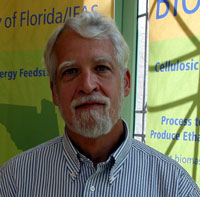 DomesticFuel did a
DomesticFuel did a 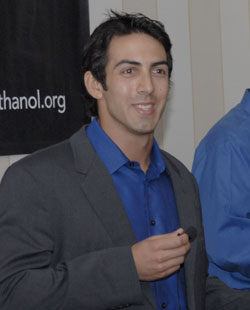 Now former Team Ethanol car driver Jeff Simmons
Now former Team Ethanol car driver Jeff Simmons 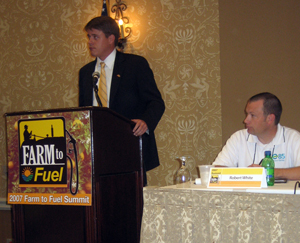 The
The